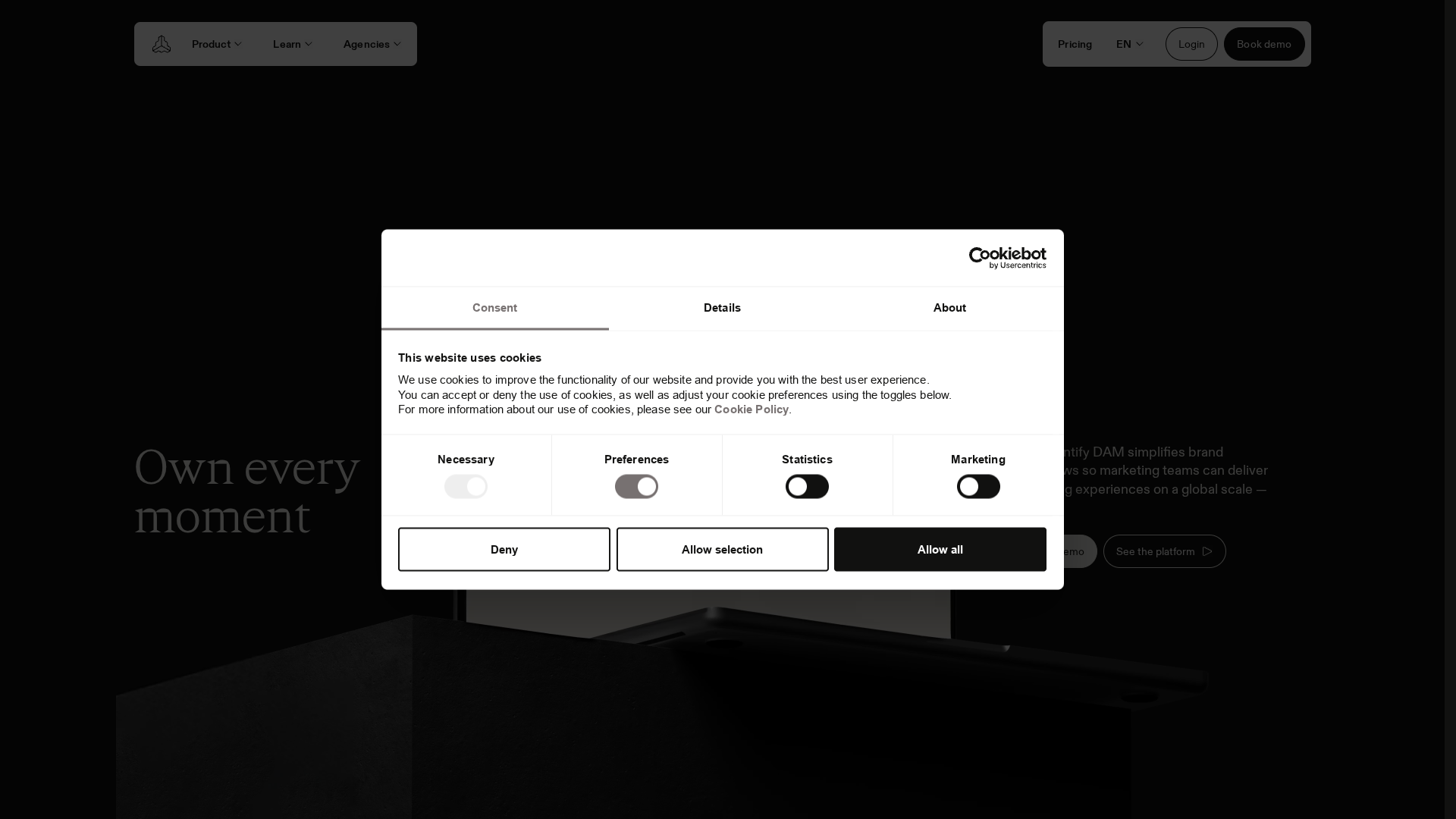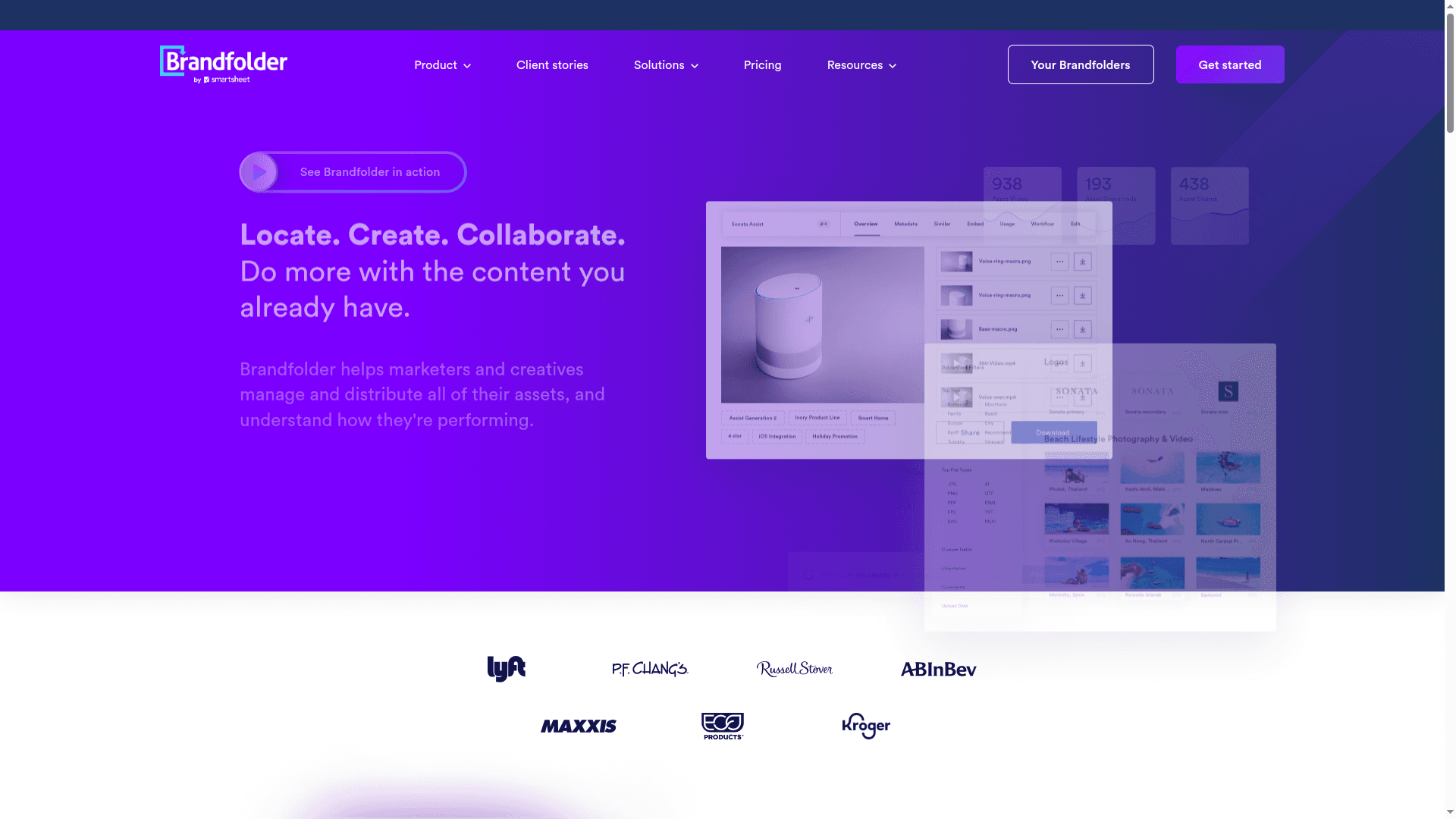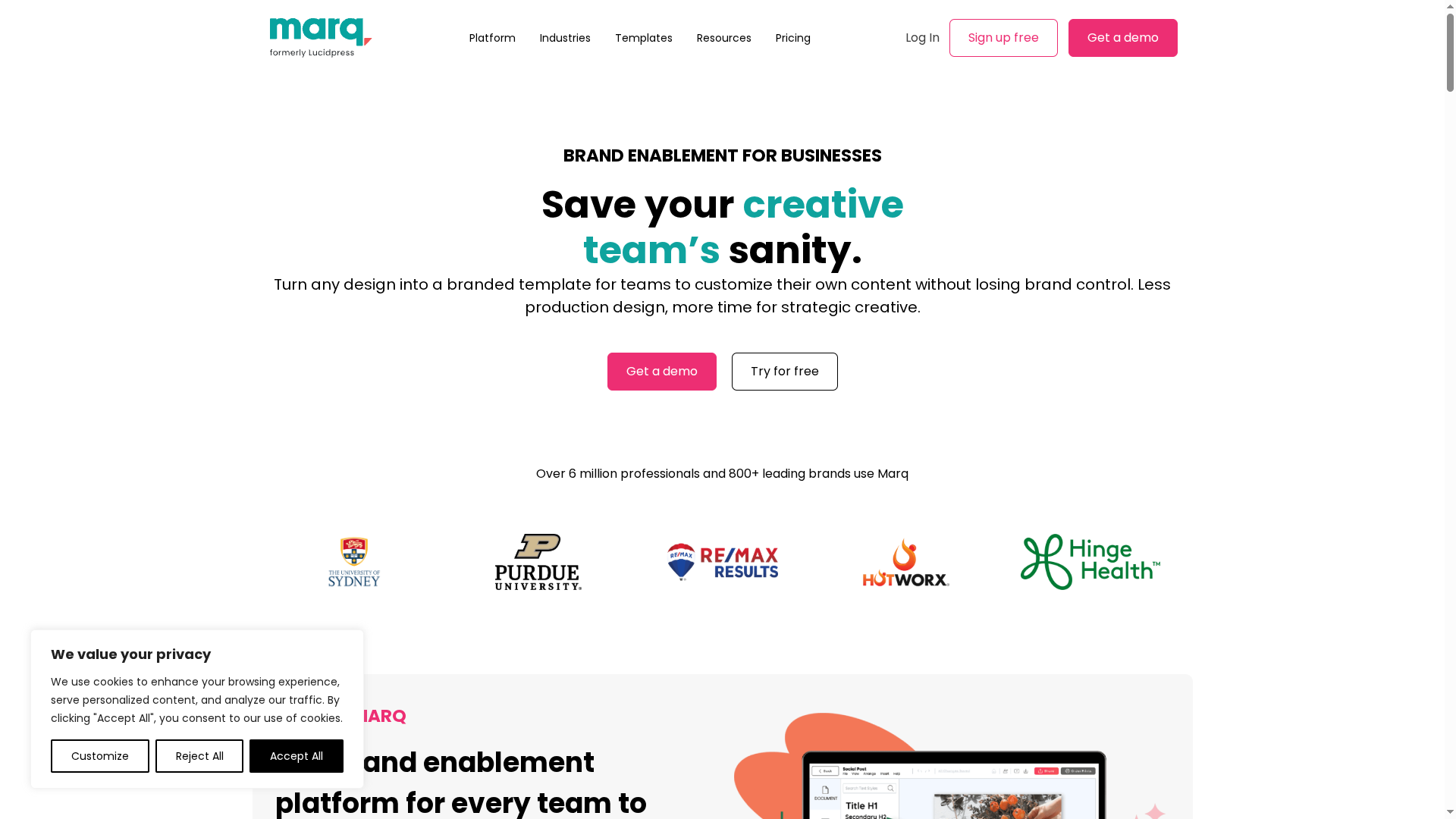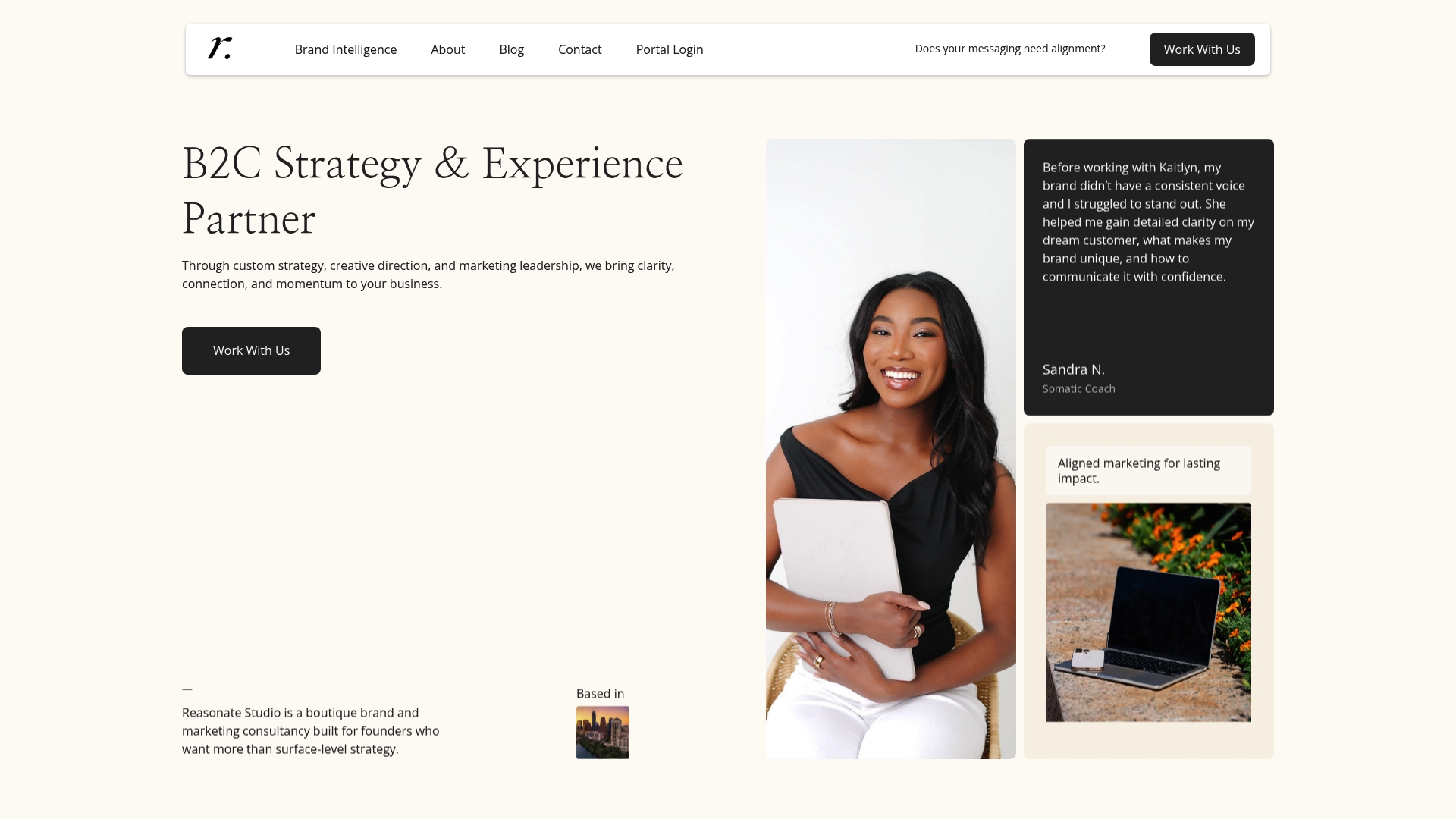Branding Strategies: Building Impactful Small Businesses

Discover the best branding software for agencies in our comparison of 4 top products, helping you choose the right tool for your needs.

Choosing the right tools to manage your brand can make a world of difference for how your business grows and connects with people. Teams want something that brings clarity instead of chaos, and founders need solutions that guide both strategy and day to day tasks. Whether you care most about creative control, easy collaboration, or finding what works without extra effort, the best options today promise more than just keeping files in order. Some focus on hands on strategy and personal touch, others highlight sharing and protecting assets across teams or building templates that anyone can use. The real question is which approach makes sense for your goals and how each product stands out where it matters most.

Reasonate Studio is a boutique brand and marketing consultancy built for founders and small businesses that want more than surface-level design. With a clear focus on mapping brand foundation to execution, Reasonate helps teams clarify messaging and implement marketing strategies that drive sustainable growth. If you’re looking for a strategic partner who treats branding as an operational system rather than a one-off project, Reasonate is built for you.
Reasonate’s main capabilities center on custom strategy development and creative marketing leadership grounded in a proprietary framework: the aligned impact model™. That framework maps values, positioning, and audience definition directly into content planning and campaign execution support, while also shaping messaging and voice. Practically, that means Reasonate blends brand strategy, audience definition, content planning, and marketing systemizations to create repeatable workflows that align creative work with measurable outcomes.
Reasonate is ideal for founders, solo entrepreneurs, and small teams who are ready to move beyond ad-hoc graphics or inconsistent copy and want a cohesive brand system that supports growth. Whether you’re a startup defining your brand foundation or a small business ready to tighten messaging and run repeatable campaigns, Reasonate’s boutique approach fits organizations that need strategic clarity paired with practical execution.
Reasonate’s distinction lies in combining boutique creative leadership with a repeatable strategic framework. The aligned impact model™ is more than a discovery workshop: it is a diagnostic and roadmap that directly ties brand foundations (values, positioning, audience) to content and campaign execution. That continuity—strategy translated into operational marketing systems and content plans—reduces wasted effort and keeps every initiative accountable to brand goals. In short: Reasonate isn’t just branding for its own sake; it builds a single, traceable line between who you are, how you talk, and how you grow. For small teams constrained by time and budget, that unified approach is a force multiplier when compared to fragmented vendors who deliver creative without strategy.
A startup needs to define its brand foundation, shape voice and messaging, then launch targeted campaigns to attract early customers. Reasonate builds the brand map, creates messaging frameworks, plans content, and supports campaign execution—turning an uncertain brand identity into consistent, growth-focused marketing activity.
Not specified on the website
Website: https://reasonatestudio.com

Frontify is a centralized brand management platform built to keep large teams and multi‑brand organizations aligned. It bundles a robust digital asset management (DAM) system, centralized brand guidelines, templating, and integrations designed for enterprise-scale collaboration. If your pain point is scattered logos, inconsistent messaging, or slow agency handoffs, Frontify aims to plug those leaks — though the complexity and cost can be a barrier for smaller teams.
Frontify’s core capabilities center on creating a single source of truth for brand assets and rules. Its DAM stores and organizes logos, images, and design files with permissions and security controls. Brand guidelines live in a central space so teams reference the same voice, color, and usage rules. Built‑in templates help non‑designers produce on‑brand materials fast, while integrations connect Frontify with other tools to smooth go‑to‑market workflows. Enterprise features like single sign‑on and custom permissions aim to protect assets and keep compliance intact across regions.
Frontify is best suited for large marketing and brand teams within enterprises that manage multiple brands, regional teams, or frequent agency partnerships. If you need secure control over assets, centralized governance, and workflows that scale across markets, Frontify fits. If you’re a solo founder or an early‑stage team on a tight budget, the platform’s scope may be more than you need.
Frontify’s unique value lies in consolidating brand governance, assets, and production-ready templates into one secure platform designed for scale. Rather than a file dump, it creates a governed ecosystem where brand rules, approvals, and integrations reduce friction between strategy and execution.
A global company uses Frontify to centralize logos, imagery, and usage rules, enabling regional teams and external agencies to build compliant campaigns quickly. The result is faster creative turnarounds, fewer brand violations, and a single place to audit assets and permissions.
Quote‑based (MAU model) — pricing is tailored to usage and requires speaking with sales for detailed packages.
Website: https://frontify.com

Brandfolder is a cloud-based digital asset management (DAM) platform built to help marketers and creatives organize, share, and measure the performance of brand assets. Its strongest cards are usability and analytics: teams can find files fast, control access, and see which assets actually move the needle. For agencies and small teams scaling from side-hustle to serious client work, Brandfolder offers enterprise-grade controls without feeling painfully complex—although advanced customization can require training.
Brandfolder combines an intuitive, cloud-first interface with robust permissioning and distribution capabilities. You can share individual assets, curated collections, or whole brand portals while enforcing privacy controls. Built-in brand intelligence surfaces asset performance and user engagement so you can prioritize what’s working. Automation features—like automated tagging and duplicate detection—help keep large libraries tidy, and integrations allow the DAM to slot into everyday workflows.
Brandfolder is best for organizations that manage a high volume of digital content and need both control and insight—marketing teams, creative agencies, and growing companies that require distributed asset access. If you’re a solo founder with modest asset needs, Brandfolder’s power may exceed your requirements; but for teams moving beyond ad hoc file-sharing, it becomes a time-saver and governance tool.
Brandfolder’s unique value is the combination of user-friendly asset access with enterprise-grade analytics and permissions. It doesn’t just store files—it tells you how assets perform and automates housekeeping so your library remains useful rather than cluttered. That intelligence is the difference between a static folder and an actionable brand system.
Conga consolidated multiple systems into Brandfolder and enabled a global team of 1,200 employees to self-serve assets, producing a reported annual savings of over $300,000. That example highlights Brandfolder’s strength at scale: lower administrative overhead, faster asset distribution, and measurable cost savings.
Quote-based: Brandfolder offers Premium and Enterprise options tailored to different organizational sizes and needs; detailed pricing requires a demo or sales conversation.
Website: https://brandfolder.com

Marq is a brand enablement platform built to help teams create, customize, and distribute on-brand visual content at scale. It shines when organizations need lockable templates, simple personalization, and centralized distribution to eliminate repetitive design requests. If your bottleneck is inconsistent collateral across teams or franchises, Marq is clearly worth evaluating — but expect a quote-based sales process and a learning curve for advanced workflows.
Marq centers on templated design and brand control: import existing assets or design in-platform, convert layouts into lockable templates, and personalize outputs for different audiences. It supports a broad library of content types (brochures, social posts, flyers, listing presentations) and industry-specific templates for real estate, education, healthcare, finance, and franchises. Distribution features let teams share content across channels instantly, and Marq integrates with data sources to automate personalized materials at scale.
Marq suits organizations that publish frequent, branded materials across multiple teams or locations — think franchises, multi-branch service providers, and real estate brokerages. It’s especially useful when internal design resources are limited and you need non-design staff to generate professional collateral quickly and consistently.
Marq’s core value is brand-safe scale: it blends template locking, personalization, and channel distribution so teams can self-serve high-quality, consistent materials without sacrificing brand control. That balance between autonomy and governance is its key differentiator.
A real estate agency uses Marq to pull MLS data into templated listing presentations, flyers, and mailers so individual agents can generate polished, compliant materials in minutes — ensuring speed to market and consistent brand presentation across dozens of agents.
Quote-based — pricing is not specified on the website and appears to be customized based on organizational needs.
Website: https://marq.com
This table provides a comparative overview of various brand management and marketing tools, highlighting their key features, pros, cons, and target audience to help businesses make informed choices.
| Product | Key Features | Pros | Cons | Target Audience |
|---|---|---|---|---|
| Reasonate | Custom strategy, creative leadership, aligned impact model™ | Trusted by 100+ businesses, campaign reach at scale, focuses on long-term growth, strategic branding | Pricing not specified | Founders, solo entrepreneurs, small teams |
| Frontify | Centralized brand management, DAM, enterprise collaboration | Improves brand consistency, enhances collaboration, scalable for enterprise | Pricing quote-based, steep learning curve, costly for smaller teams | Large enterprises managing multiple brands |
| Brandfolder | Cloud-based DAM, intuitive interface, strong analytics | User-friendly, strong permissions, actionable analytics, scalable | Requires training for customization, pricing barriers, incomplete feature details | Agencies, creative teams, growing companies |
| Marq | Templated design, lockable templates, personalization at scale | Empowers non-designers, cuts production time, strong brand consistency, versatile content support | Pricing not transparent, complex features, sparse integration details | Franchises, multi-branch service providers, real estate brokerages |
Many agencies and small businesses struggle to bridge the gap between creative branding and measurable marketing outcomes. This article highlights the need for strategic frameworks that translate brand foundations into sustainable growth—not just surface-level logos or disjointed campaigns. If you find yourself spinning your wheels with inconsistent messaging or fragmented workflows, the challenge is clear: you need a system that unites brand identity, storytelling, and execution seamlessly.
Reasonate Studio solves this problem with The Aligned Impact Model™, a proprietary framework that maps what truly makes your brand resonate—like values, positioning, and audience insights—directly into marketing plans that drive results. Whether you are a founder ready to scale or an agency seeking clarity and repeatable workflows, Reasonate’s approach combines strategy, creativity, and operational discipline in a way that feels approachable and intentional. This means less wasted effort and more confident decisions backed by emotional intelligence and business goals.
Looking to take control of your branding strategy today?

Discover how partnering with a boutique agency focused on long-term impact can transform your marketing approach. Visit Reasonate Studio and explore how to build a cohesive brand system that works as hard as you do. Start the journey toward clarity, strategy, and growth by connecting with us now here. Don’t settle for fragmented branding when you can have a trusted partner to guide your success.
Choosing branding software for your agency should involve factors such as usability, collaboration features, and scalability. Assess how well the software can integrate with your existing tools and how it handles brand asset management. Evaluate at least three options based on these criteria to determine the best fit.
Branding software streamlines your agency’s workflow by centralizing assets, reducing duplication of work, and enhancing team collaboration. Implement a system that allows for easy access to brand guidelines and assets to save time — ideally cutting time spent on design requests by up to 30%.
Look for features that include digital asset management, customizable templates, collaborative tools, and analytics for measuring the effectiveness of campaigns. Prioritize software that enables your team to create on-brand materials quickly and consistently for the best results.
To measure the effectiveness of branding software, establish key performance indicators like time saved on project completion, consistency of brand usage, and user engagement rates. Implement tracking systems to gather data and evaluate performance quarterly to refine your branding approach.
Yes, branding software is beneficial for small agencies as it helps establish a professional brand presence while improving internal processes and collaboration. Start with a user-friendly platform to simplify implementation and experience improvements within the first 60 days of use.
Regularly update your branding software to keep up with new features and security measures. Aim to review and update the software at least once a year to ensure it continues to meet your agency’s evolving needs and leverage any new capabilities.